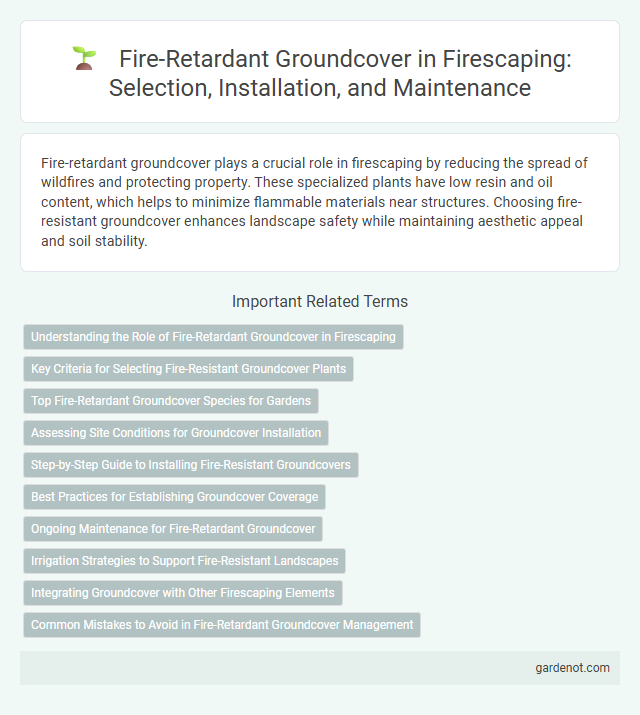Fire-retardant groundcover plays a crucial role in firescaping by reducing the spread of wildfires and protecting property. These specialized plants have low resin and oil content, which helps to minimize flammable materials near structures. Choosing fire-resistant groundcover enhances landscape safety while maintaining aesthetic appeal and soil stability.
Understanding the Role of Fire-Retardant Groundcover in Firescaping
Fire-retardant groundcover plays a critical role in firescaping by reducing the intensity and spread of wildfires near homes and structures. These specialized plants have high moisture content and low flammability, creating a natural barrier that slows fire progression. Integrating fire-retardant groundcover into landscape design enhances property protection and increases overall fire resilience.
Key Criteria for Selecting Fire-Resistant Groundcover Plants
Fire-retardant groundcover plants must have low flammability, high moisture content, and minimal resin or oil presence to reduce fire spread risk. Selection criteria emphasize species with thick, fleshy leaves that retain water and resist drying, such as certain succulents and native drought-tolerant plants. Durable root systems and the ability to form dense mats also contribute to effective fire resistance in landscapes designed for firescaping.
Top Fire-Retardant Groundcover Species for Gardens
Ceanothus, manzanita, and succulents such as sedum are top fire-retardant groundcover species prized for their low flammability and high moisture content. These plants help create defensible space around homes by reducing fuel load and slowing wildfire spread. Selecting fire-resistant groundcovers that thrive in your garden's climate enhances landscape resilience and safety during fire season.
Assessing Site Conditions for Groundcover Installation
Assessing site conditions for fire-retardant groundcover installation involves evaluating soil type, moisture levels, and sun exposure to ensure optimal plant growth and fire resistance. Identifying slopes and fuel sources nearby helps determine the best groundcover selection that minimizes fire risk. Proper site assessment enhances the effectiveness of fire-retardant vegetation in creating defensible spaces around properties.
Step-by-Step Guide to Installing Fire-Resistant Groundcovers
Begin by selecting fire-retardant groundcovers such as ice plant, succulents, or creeping sedum known for their low flammability and moisture retention. Prepare the soil by clearing debris, loosening the top layer, and applying a layer of fire-resistant mulch before planting to enhance fire resistance. Space plants according to growth patterns, water regularly to maintain moisture levels, and inspect periodically to remove dead material, ensuring an effective fire-resilient landscape.
Best Practices for Establishing Groundcover Coverage
Selecting native, drought-tolerant fire-retardant groundcover species such as creeping mahonia, ice plant, or succulents maximizes resistance to ignition and minimizes fire spread. Site preparation includes clearing all flammable debris, loosening soil for optimal root penetration, and applying mulch with non-combustible materials like gravel to reduce fuel load. Regular maintenance involves pruning dead material, monitoring plant health, and maintaining appropriate irrigation to ensure continuous, dense coverage that acts as an effective firebreak.
Ongoing Maintenance for Fire-Retardant Groundcover
Ongoing maintenance for fire-retardant groundcover involves regular watering, pruning, and debris removal to preserve the plant's fire-resistant properties. Monitoring soil moisture and ensuring proper fertilization support vigorous growth, which enhances the groundcover's ability to act as a fire barrier. Consistent inspection for dead or dried foliage prevents fuel buildup, reducing wildfire risk and maintaining landscape safety.
Irrigation Strategies to Support Fire-Resistant Landscapes
Effective irrigation strategies are crucial for maintaining fire-retardant groundcover by ensuring adequate moisture levels that inhibit combustion. Drip irrigation systems deliver precise water directly to roots, reducing evaporation and conserving water while promoting healthy, fire-resistant plants. Consistent soil hydration combined with scheduled watering during dry periods enhances the resilience of groundcover against wildfires.
Integrating Groundcover with Other Firescaping Elements
Fire-retardant groundcover works effectively when integrated with fire-resistant hardscapes and strategically placed shrubs to create defensible spaces around structures. Combining non-flammable mulch materials and fire-resistant plants enhances the overall protection by reducing fuel continuity and minimizing ember ignition risks. Proper layering of groundcover with walkways, retaining walls, and spacing guidelines further strengthens the firebreak and aids in controlling fire spread.
Common Mistakes to Avoid in Fire-Retardant Groundcover Management
Using non-fire-resistant plants as groundcover increases vulnerability to fire spread during wildfires. Overwatering fire-retardant groundcover can reduce plant resilience and promote fungal diseases, undermining fire resistance. Neglecting regular clearing of dead leaves and debris allows combustible material to accumulate, offsetting the benefits of fire-retardant landscaping.
Fire-retardant Groundcover Infographic

 gardenot.com
gardenot.com